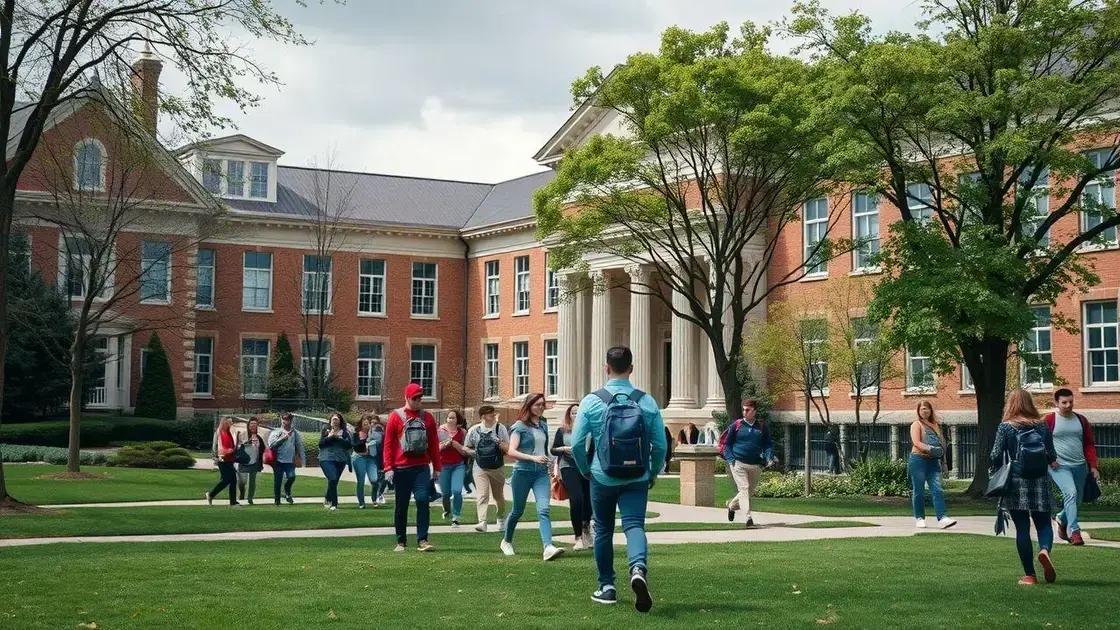School voucher programs: unlocking educational opportunities

Anúncios
School voucher programs provide families with funds to choose educational options outside public schools, aiming to enhance educational choice while facing challenges like funding issues and equity concerns.
School voucher programs are sparking conversations about education reform across the country. But have you ever wondered how these initiatives affect students and families? Let’s dive deeper.
What are school voucher programs?
School voucher programs provide families with the flexibility to choose where their children go to school. These programs are designed to give parents more control over their children’s education, especially in areas where public schools may not meet their needs.
Essentially, a school voucher is a government-funded certificate that parents can use to pay for tuition at a private or alternative public school. This initiative aims to promote competition among schools, encouraging them to improve their services and educational quality.
How do school voucher programs work?
The mechanics of these programs can vary widely, but here are some common features:
- Parents apply for vouchers through a designated agency.
- The voucher amount can cover full or partial tuition.
- Funds may be allocated based on a child’s income level or special needs.
- Participating schools must meet certain criteria set by the program.
Supporters of school voucher programs argue that they provide essential educational choices for low-income families. These options can lead to better academic outcomes and improved overall satisfaction with schooling choices.
On the other hand, critics worry that such programs may drain funding from public schools and encourage segregation based on socioeconomic status. They also question whether private schools can provide better education than public schools.
Types of school voucher programs
There are different forms of school voucher programs, including:
- Universal vouchers, which are available to all families regardless of income.
- Needs-based vouchers, targeting low-income families.
- Special needs vouchers, designed specifically for children with disabilities.
The debate surrounding school voucher programs continues as states and communities evaluate their efficacy and impact on the educational landscape.
Key benefits of school vouchers
School vouchers offer several advantages that can significantly impact students and families. Understanding these benefits is essential for evaluating the effectiveness of such programs.
One key benefit of school vouchers is that they enhance educational choice. Parents can select the school that best fits their child’s needs, whether it’s a public, charter, or private institution. This flexibility allows families to find educational environments that align with their values and academic requirements.
Improved Student Outcomes
Research has shown that students using vouchers often experience improved academic performance. Enrolling in schools that match their learning style may boost motivation and engagement, leading to better outcomes. Additionally, when schools know they are competing for students, they tend to enhance their quality of education and services.
- More personalized education plans
- Increased parental involvement
- Greater accountability from schools
Another significant benefit is the promotion of equity in education. Vouchers can help level the playing field for students from disadvantaged backgrounds, giving them access to quality education options that would otherwise be unavailable due to financial constraints.
Cost savings associated with school vouchers can also be a notable advantage. Private schools often operate with lower per-student funding compared to public schools, which can result in reduced taxpayer burden. Consequently, this can allow for better allocation of funds within the educational system.
Diverse Learning Environments
Vouchers facilitate exposure to a variety of learning environments. This diversity can improve educational experience by introducing different instructional methods and curricular choices. Students may thrive in innovative settings that foster creativity and critical thinking, leading to well-rounded development.
- Focus on STEM, arts, or special education
- Diverse student populations
- Expanded extracurricular activities
In summary, the key benefits of school vouchers are numerous and can reshape the educational landscape for families seeking better opportunities for their children. Understanding these advantages helps to foster informed discussions about the future of education.
Challenges in school voucher implementation

Implementing school voucher programs is not without its challenges. While these programs can offer great benefits, several obstacles can hinder their success.
One significant issue is the equity concern. Critics argue that vouchers can exacerbate socioeconomic divisions. Families with the resources to navigate the system may benefit more than those without. This can lead to gaps in educational access, wherein only certain demographics leverage voucher opportunities.
Funding and Resource Allocation
Funding is another major concern. School voucher programs often rely on funds that are diverted from public schools. This can lead to budget cuts in essential services, impacting students who remain in these schools. The financial strain on public institutions can be severe, resulting in fewer resources for students left behind.
- Reduction in teacher salaries
- Increased class sizes
- Limited course offerings
Another challenge involves the regulation of private schools. There can be significant variation in quality among schools that accept vouchers. Unlike public schools, many private institutions may not be held to the same accountability standards. This raises questions about the quality of education that voucher students receive, as not all private schools may offer adequate educational experiences.
Moreover, the logistical challenges involved in administering these programs can complicate matters. Families often face difficulties navigating the application process for vouchers, which can be confusing and time-consuming. Issues like meeting eligibility criteria also come into play, as families may have trouble understanding the requirements.
Political Resistance
Finally, political resistance can hinder the implementation of school voucher programs. Legislators may be divided on the issue, leading to inconsistent policies and regulations across states. These divisions can stall progress and hinder meaningful reform in the educational sector. The ongoing dialogues about the effectiveness and fairness of vouchers remain hotly debated among stakeholders.
Despite these challenges, understanding the obstacles that come with school voucher programs is crucial for policymakers and educators alike. By addressing these issues, it is possible to enhance the effectiveness of such programs and expand educational opportunities for all students.
Impact on public schools
The use of school vouchers has a significant impact on public schools, altering how they operate and serve their communities. As families choose to take vouchers to attend private or charter schools, public institutions often face resource challenges.
One evident effect is the potential for decreased funding. When students leave for schools funded by vouchers, public schools may receive less financial support. This reduction can lead to cuts in programs, teacher positions, and essential services necessary for student success.
Changes in Enrollment
As enrollment numbers decline, public schools might struggle to maintain a balanced budget. Lower student counts can result in:
- Higher student-to-teacher ratios
- Increased class sizes
- Limited extracurricular activities
These factors can adversely affect student performance and satisfaction, leading to a cycle of further enrollment declines. When schools cannot adequately support students, parents may be more inclined to seek alternative education options.
Moreover, public schools face pressure to improve their quality due to competition from voucher schools. When private institutions capitalize on their freedom from some regulations, public schools may feel compelled to enhance their offerings. This raises the question: Are public schools adequately equipped to adjust to such competition?
Accountability and Performance
The introduction of vouchers also brings up issues of accountability. Public schools are subject to strict guidelines and assessments, while many private schools face different levels of scrutiny. This disparity can create an uneven playing field, where public schools are held to standards that may not apply equally to their private counterparts.
This situation prompts a need for discussions about how to ensure quality across all educational options. Parents require confidence that their children are receiving a high-quality education, regardless of the type of school they attend. It also leads public schools to look for innovative strategies to remain competitive.
The overall impact of school vouchers on public education is complex. It challenges schools to adapt while highlighted by both opportunities and difficulties that accompany these changes.
Comparative analysis of school voucher systems
A comparative analysis of school voucher systems reveals significant differences in how they function across various regions. Each state or country implementing school voucher programs adapts its approach based on local policies and educational needs.
One aspect to consider is the funding structure. Some voucher systems provide full tuition coverage, while others offer partial funding. This variation can affect which families are able to take advantage of the vouchers. In some places, $2,000 might be enough to cover tuition at a private school, but in areas with higher living costs, it may fall short.
Types of Voucher Systems
Different states have distinct types of voucher systems. These include:
- Universal vouchers that are available to all students.
- Income-based vouchers that target low-income families.
- Special needs vouchers specifically designed for students with disabilities.
Each type caters to specific needs within the educational landscape, impacting participation rates and the overall effectiveness of the programs.
Another crucial factor in a comparative analysis is the regulatory environment. Some states impose rigorous accountability measures on both public and private schools, ensuring quality education across the board. Others may allow private schools to operate with minimal oversight, which raises questions about educational standards and student outcomes.
Impact on Public Schools
The impact of voucher systems on public schools can also vary significantly. In some areas, public schools may face challenges such as budget cuts and decreased enrollment, while in others, the competition may drive improvements. Public sentiment and local politics can play influential roles in how voucher programs are perceived and implemented.
Furthermore, student performance metrics should be examined in a comparative context. Studies have shown mixed results regarding whether students who utilize vouchers perform better academically than their peers in public schools. Discrepancies often arise from the differing educational environments and support systems available to each group of students.
Finally, understanding the broader societal impacts of school voucher programs is crucial. Are they fostering greater equity in education or are they widening existing gaps? Comparing systems helps identify best practices, which can inform future policy decisions and enhance the educational landscape for all students.
The impact of school voucher programs is multifaceted and continues to stir debate. By giving families the choice of where to send their children to school, these programs can create opportunities for better education. However, challenges such as funding issues, equity concerns, and varying quality in private institutions cannot be ignored. It’s crucial for policymakers to evaluate the effectiveness of these programs continuously and ensure that they serve all communities fairly. As education evolves, understanding the role of vouchers will be key to supporting students and improving educational outcomes for everyone.
FAQ – School Voucher Programs
What are school voucher programs?
School voucher programs are initiatives that provide families with funds to pay for their children’s education at private or alternative public schools.
How do school vouchers affect public schools?
School vouchers can lead to decreased funding for public schools as funds are redirected to other educational institutions, potentially impacting resources and quality.
What are the benefits of school voucher programs?
Benefits include increased educational choice for families, potential improvement in student outcomes, and the promotion of competition among schools.
What challenges do school voucher programs face?
Challenges include equity concerns, funding issues, varied accountability standards for private schools, and potential negative impacts on public education.






